6-6 duoprism
In geometry of 4 dimensions, a 6-6 duoprism or hexagonal duoprism is a polygonal duoprism, a 4-polytope resulting from the Cartesian product of two hexagons.
Uniform 6-6 duoprism Schlegel diagram | |
|---|---|
| Type | Uniform duoprism |
| Schläfli symbol | {6}×{6} = {6}2 |
| Coxeter diagrams | |
| Cells | 12 hexagonal prisms |
| Faces | 36 squares, 12 hexagons |
| Edges | 72 |
| Vertices | 36 |
| Vertex figure | Tetragonal disphenoid |
| Symmetry | [[6,2,6]] = [12,2+,12], order 288 |
| Dual | 6-6 duopyramid |
| Properties | convex, vertex-uniform, facet-transitive |
It has 36 vertices, 72 edges, 48 faces (36 squares, and 12 hexagons), in 12 hexagonal prism cells. It has Coxeter diagram ![]()
![]()
![]()
![]()
![]()
![]()
![]()
Images
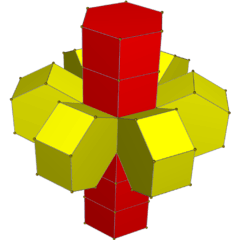
Net
Seen in a skew 2D orthogonal projection, it contains the projected rhombi of the rhombic tiling.
 |
 |
| 6-6 duoprism | Rhombic tiling |
|---|---|
 |
 |
| 6-6 duoprism | 6-6 duoprism |
Related complex polygons

The regular complex polytope 6{4}2, ![]()
![]()
![]()
![]()
![]()
![]()
6-6 duopyramid
| 6-6 duopyramid | |
|---|---|
| Type | Uniform dual duopyramid |
| Schläfli symbol | {6}+{6} = 2{6} |
| Coxeter diagrams | |
| Cells | 36 tetragonal disphenoids |
| Faces | 72 isosceles triangles |
| Edges | 48 (36+12) |
| Vertices | 12 (6+6) |
| Symmetry | [[6,2,6]] = [12,2+,12], order 288 |
| Dual | 6-6 duoprism |
| Properties | convex, vertex-uniform, facet-transitive |
The dual of a 6-6 duoprism is called a 6-6 duopyramid or hexagonal duopyramid. It has 36 tetragonal disphenoid cells, 72 triangular faces, 48 edges, and 12 vertices.
It can be seen in orthogonal projection:
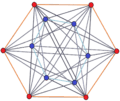 | 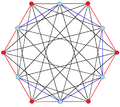 | 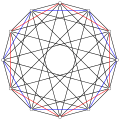 |
| Skew | [6] | [12] |
|---|
Related complex polygon
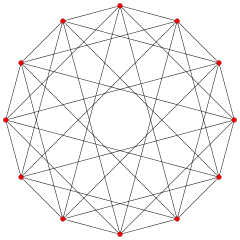
The regular complex polygon 2{4}6 or ![]()
![]()
![]()
The vertices and edges makes a complete bipartite graph with each vertex from one pentagon is connected to every vertex on the other.[2]
Related polytopes
The 3-3 duoantiprism is an alternation of the 6-6 duoprism, but is not uniform. It has a highest symmetry construction of order 144 uniquely obtained as a direct alternation of the uniform 6-6 duoprism with an edge length ratio of 0.816 : 1. It has 30 cells composed of 12 octahedra (as triangular antiprisms) and 18 tetrahedra (as tetragonal disphenoids). The vertex figure is a gyrobifastigium, which has a regular-faced variant that is not isogonal. It is also the convex hull of two uniform 3-3 duoprisms in opposite positions.
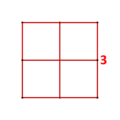
Vertex figure for the 3-3 duoantiprism
See also
- 3-3 duoprism
- 3-4 duoprism
- 5-5 duoprism
- Tesseract (4-4 duoprism)
- Convex regular 4-polytope
- Duocylinder
Notes
- Coxeter, H. S. M.; Regular Complex Polytopes, Cambridge University Press, (1974).
- Regular Complex Polytopes, p.114
References
- Regular Polytopes, H. S. M. Coxeter, Dover Publications, Inc., 1973, New York, p. 124.
- Coxeter, The Beauty of Geometry: Twelve Essays, Dover Publications, 1999, ISBN 0-486-40919-8 (Chapter 5: Regular Skew Polyhedra in three and four dimensions and their topological analogues)
- Coxeter, H. S. M. Regular Skew Polyhedra in Three and Four Dimensions. Proc. London Math. Soc. 43, 33-62, 1937.
- John H. Conway, Heidi Burgiel, Chaim Goodman-Strass, The Symmetries of Things 2008, ISBN 978-1-56881-220-5 (Chapter 26)
- Norman Johnson Uniform Polytopes, Manuscript (1991)
- N.W. Johnson: The Theory of Uniform Polytopes and Honeycombs, Ph.D. Dissertation, University of Toronto, 1966
- Catalogue of Convex Polychora, section 6, George Olshevsky.
External links
- The Fourth Dimension Simply Explained—describes duoprisms as "double prisms" and duocylinders as "double cylinders"
- Polygloss - glossary of higher-dimensional terms
- Exploring Hyperspace with the Geometric Product